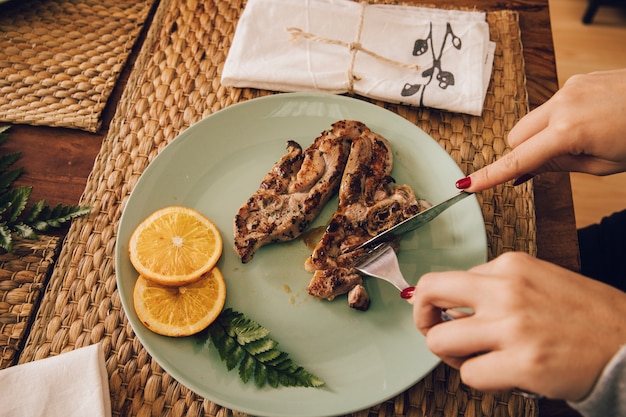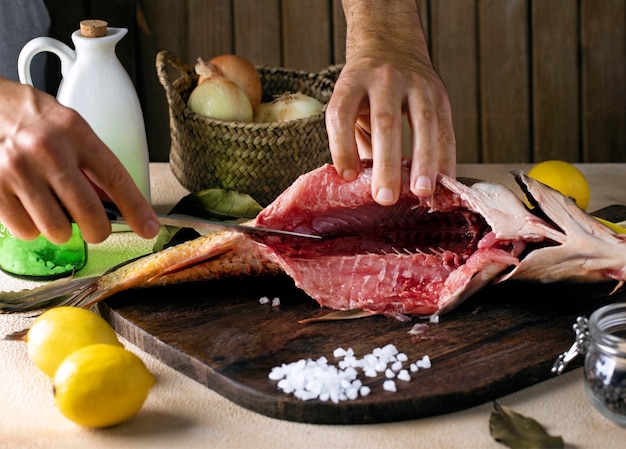There's nothing quite like sinking your teeth into a perfectly cooked steak. The glistening surface, the satisfying sizzle, and the rich aroma - it's a culinary experience that transports you to a world of pure indulgence. But achieving that perfect medium-well sear, the kind that leaves you with a juicy, tender interior and a flavorful, crisp crust, is no easy feat. Believe me, I've been there, staring at a charred, dry, or tragically undercooked steak, wondering what went wrong.
I've spent countless hours in the kitchen, experimenting with different cuts, temperatures, and techniques. I've learned the hard way that a medium-well steak is a delicate dance, a symphony of timing and precision. But through trial and error, I've finally cracked the code, and I'm ready to share my secrets with you. Get ready to elevate your steak game, my friend, because by the end of this guide, you'll be a medium-well master.
(Part 1) Picking Your perfect steak

choosing the right cut: A Matter of Flavor and Texture
The journey to a perfect steak starts with choosing the right cut. While every cut boasts its own unique character, some are better suited for achieving that medium-well magic. For example, leaner cuts like sirloin or ribeye hold their shape during cooking, making them ideal candidates for a medium-well sear. They're less likely to become dry and tough, which is a common concern with medium-well doneness.
Here are some of my personal favorites for medium-well steaks, each offering a unique flavor and texture experience:
- Sirloin: This classic cut is a steadfast choice for medium-well, known for its leanness, tenderness, and robust flavor. It's the perfect canvas for a flavorful crust and a satisfying bite.
- Ribeye: The king of juicy steaks, ribeye offers an incredible marbling of fat that melts beautifully during cooking, resulting in a rich, buttery flavor. It's a real treat for steak lovers who appreciate a little decadence.
- new york strip: With a similar rich marbling to ribeye, the New York strip boasts a slightly more pronounced flavor and a slightly more tender texture. It's a versatile cut that shines when cooked medium-well.
- Top Sirloin: A more budget-friendly option, top sirloin still delivers a satisfying experience. It offers a good balance of flavor and tenderness, making it a great choice for a casual weeknight meal or a special occasion.
However, thicker cuts like T-bone and porterhouse, while undeniably delicious, require a more delicate touch when aiming for medium-well. They're better suited for medium-rare or medium, where their thickness allows for a more forgiving cooking process.
Thickness Matters: The Perfect Balance
The thickness of your steak is another critical factor in achieving that perfect medium-well. A 1-inch thick steak is generally considered ideal. It allows for a beautiful crust on the outside while ensuring the interior cooks evenly to the desired doneness. Thinner steaks can easily overcook, while thicker steaks might require additional cooking time, increasing the risk of dryness.
Prepping Your Steak: Setting the Stage for Success
Once you've chosen the perfect steak, it's time to prepare it for its starring role. Pat it dry with paper towels to remove any excess moisture. This step is crucial for achieving that coveted crispy crust. Next, generously season the steak with salt and pepper. Don't be shy with the salt; it will enhance the steak's natural flavors. You can also experiment with other seasonings, like garlic powder, onion powder, or smoked paprika, to add a unique depth of flavor. Just remember to taste-test as you go to find your perfect balance.
(Part 2) Searing to Perfection: The Art of the Crust

The Heat is On: A Sizzling Start
For a steak that boasts a beautiful, crispy crust and a tender, flavorful interior, you need a screaming hot pan. Heat a cast iron skillet or a heavy-bottomed pan over high heat. If using a gas stove, aim for a medium-high flame. A hot pan ensures a rapid sear, creating a barrier that locks in the juices and enhances the flavor.
A simple water test will confirm whether your pan is hot enough. Add a drop of water. If it sizzles and evaporates instantly, you're ready to roll. If it lingers or just barely sizzles, give your pan a few more minutes to reach its peak heat.
Time for the Steak: The First Encounter
Once your pan is sizzling, carefully place your steak in the skillet. Don't overcrowd the pan; cook your steaks in batches if necessary. Let the steak cook undisturbed for 2-3 minutes per side, or until a beautiful, golden-brown crust forms. Resist the urge to move or flip the steak too early; allow the heat to do its magic and create that signature sear.
Flipping Time: The Art of the Second Impression
After the initial sear, carefully flip the steak over. You'll notice a lovely, crispy texture on the first side. Continue searing the second side for 2-3 minutes, ensuring an even crust. Pay attention to the edges of the steak, ensuring they achieve the same lovely browning as the main surface.
(Part 3) Finishing the Cooking Process: Achieving Even Doneness

Reducing the Heat: A Gentle Transition
After achieving that satisfying sear, it's time to reduce the heat to medium or medium-low to finish cooking the steak. This step ensures that the interior cooks evenly without burning the already beautiful crust. A common pitfall in cooking medium-well steak is overdoing it on the stovetop. This can lead to a dry, chewy steak that doesn't live up to its potential. Instead, consider finishing the cooking process in the oven, allowing for a more gentle and controlled approach.
Oven Finish: A Gentle Embrace
To finish your steak in the oven, preheat it to 350°F (175°C). Transfer the pan with the seared steak into the preheated oven. You can add a knob of butter and a few sprigs of rosemary or thyme for an extra touch of flavor. Allow the steak to cook for a few more minutes, until it reaches the desired internal temperature. The oven’s gentle heat ensures that the steak cooks evenly, resulting in a juicy and flavorful interior.
Time for the Thermometer: The Ultimate Guide
This is where the magic of a meat thermometer truly shines. It's the secret weapon to achieving that perfect medium-well steak, ensuring every bite is cooked to your exact liking. For medium-well, aim for an internal temperature of 150°F (65.5°C). This temperature ensures that the steak is cooked through while retaining its juicy texture and pink center.
Cooking Times: A General Guide
Here’s a general guide for cooking times for a 1-inch thick steak, keeping in mind that actual cooking time may vary based on your stove’s heat and the thickness of your steak:
| steak cut | Total Cooking Time (Minutes) |
|---|---|
| Sirloin | 8-10 |
| Ribeye | 9-12 |
| New York Strip | 9-11 |
| Top Sirloin | 7-9 |
Remember, these are just general guidelines. It's always wise to check the internal temperature of your steak with a meat thermometer to ensure it's cooked to your liking.
(Part 4) Resting is Key: The Secret to Juiciness
Patience is a Virtue: Letting the Steak Settle
After your steak has reached the desired internal temperature, remove it from the oven and let it rest for 5-10 minutes. Resting is a crucial step in achieving a perfectly juicy steak. It allows the juices to redistribute throughout the steak, resulting in a more tender and flavorful cut. Imagine the juices as tiny little adventurers, exploring the steak's interior, making every bite a delightful experience.
Tent it Up: Keeping the Heat In
While your steak is resting, cover it loosely with aluminium foil. This helps to keep the steak warm while the juices redistribute, ensuring a satisfyingly warm and flavorful bite. It's like giving your steak a cozy little blanket while it enjoys its well-deserved break.
(Part 5) Slicing and Serving: The Grand Finale
Time to Slice: The Art of Presentation
After your steak has rested, it's time to slice and serve. Using a sharp knife, slice the steak against the grain. Slicing against the grain helps to tenderize the steak and makes it easier to chew, creating a more enjoyable eating experience. Visualize the steak's muscle fibers, and imagine cutting through them perpendicularly, like a skilled sculptor working on their masterpiece.
The Final Touches: A Symphony of Flavors
For a classic steak presentation, serve your medium-well steak on a bed of mashed potatoes or a green salad. For a more sophisticated touch, consider a bed of roasted vegetables or a creamy polenta. You can also add a drizzle of pan sauce, which is made by deglazing the pan with a little wine or broth and letting it simmer until thickened. This adds a delicious depth of flavor and a beautiful sheen to your steak.
(Part 6) Mastering the Art of Medium-Well: Tips and Tricks
Here are some additional tips and tricks to help you achieve a perfect medium-well steak every time:
- Don’t overcrowd the pan: Cook your steaks in batches if you have multiple to ensure even browning. Overcrowding the pan can hinder heat distribution, resulting in uneven cooking and a less-than-perfect crust.
- Use a meat thermometer: This is the most accurate way to ensure your steak is cooked to your liking. A meat thermometer takes the guesswork out of cooking, eliminating the risk of overcooking or undercooking your steak.
- Don’t overcook: Medium-well is a delicate balance, a point where the steak is cooked through but still retains a touch of pinkness. Once the steak reaches the desired internal temperature, remove it from the heat immediately to prevent overcooking and ensure a juicy and flavorful bite.
- Rest the steak: This is crucial for ensuring a juicy and flavorful steak. Resting allows the juices to redistribute, resulting in a more tender and flavorful cut.
- Experiment with seasonings: Don't be afraid to experiment with different seasonings to create your unique flavour combinations. From simple salt and pepper to a blend of herbs and spices, there's a world of flavor waiting to be explored.
(Part 7) The Beauty of Medium-Well: A Matter of Taste
Why I Love Medium-Well: A Personal Preference
Medium-well is my go-to doneness for steak. I love the combination of the crispy crust and the slightly pink centre. It's a perfect balance of flavor and texture, offering a delightful experience for my taste buds. It's the perfect harmony of cooked and raw, a delicate balance that satisfies both my desire for a cooked steak and my appreciation for a touch of pinkness.
Moreover, medium-well is a safe choice for those who prefer a more cooked steak, as it eliminates any potential concerns about undercooked meat. It's a great option for family meals or when entertaining friends, ensuring everyone enjoys a safe and satisfying meal.
(Part 8) Embrace the Learning Curve: A Journey of Culinary Discovery
Don’t Be Afraid to Experiment: The Joy of Trial and Error
Don’t be discouraged if your first few attempts at medium-well aren’t perfect. Like any culinary skill, mastering steak cooking takes practice and patience. Remember, every steak is a learning opportunity, a chance to refine your technique and discover what works best for you.
Experiment with different cuts, seasonings, and cooking techniques to find what works best for you. Try grilling, pan-searing, or broiling your steaks, and observe how each method affects the final outcome. With time and practice, you’ll be able to cook the perfect medium-well steak every time, impressing your friends and family with your culinary prowess.
FAQs
What happens if I overcook my steak?
Overcooking a steak can lead to a dry, chewy texture and a loss of flavor. If you accidentally overcook your steak, there are a few things you can do to try and salvage it. You can add a little bit of pan sauce or gravy to moisten the steak. Or, you can try slicing the steak thinly and using it in another dish, like a stir-fry or a salad. Remember, a slightly overcooked steak is not the end of the world. It's a chance to learn from your experience and refine your cooking techniques.
Can I use a different cooking method for medium-well?
Yes, you can use other cooking methods for medium-well, like grilling or broiling. However, you will need to adjust the cooking times accordingly. The key is to use a meat thermometer to ensure the steak reaches the desired internal temperature. Experiment with different methods, and discover which one suits your preferences and cooking style.
What if my steak isn't thick enough for medium-well?
For thinner steaks, you can adjust the cooking time and temperature. Use a higher heat to sear the steak quickly, and then finish it in the oven at a lower temperature to prevent overcooking. A thinner steak will cook faster, so adjust your cooking time accordingly. Remember, the goal is to achieve that perfect medium-well balance, ensuring the steak is cooked through while retaining its juiciness.
Is it safe to eat steak that’s cooked medium-well?
Yes, steak cooked to medium-well is safe to eat. The internal temperature of 150°F (65.5°C) is high enough to kill any harmful bacteria. However, it's always a good practice to ensure your steak is cooked to the proper temperature to eliminate any potential food safety concerns.
How do I know when my steak is done?
The best way to know when your steak is done is to use a meat thermometer. It's a reliable and accurate way to ensure your steak is cooked to your liking. You can also use the "finger test" method, but it's not as accurate as using a meat thermometer. Press the centre of the steak with your finger. If it feels firm, like the tip of your nose, it's rare. If it feels soft and spongy, like your cheek, it's medium-rare. If it feels firm and springy, like your forehead, it's medium. And if it feels firm and hard, like your chin, it's well-done. However, the finger test is not as accurate as using a meat thermometer, and it's best reserved for those times when a thermometer isn't readily available.
Everyone is watching

Corn on the Cob: The Ultimate Guide to Perfectly Cooked Ears
Healthy MealsAh, corn on the cob. Just the name evokes images of sunny days, barbecues, and that sweet, juicy flavour that ...

Scallops: The Ultimate Guide to Perfect Cooking
Healthy MealsAh, scallops. Those delicate, sweet, and utterly delicious morsels of the sea. They hold a special place in my...

Spaghetti Squash: The Ultimate Guide to Cooking and Serving
Healthy MealsRemember that time you saw spaghetti squash at the supermarket, looking all bumpy and strange, and thought, "W...

Salmon Cooking Times: Perfect Guide for Every Recipe
Healthy MealsLet me tell you, cooking salmon is an art form. It's all about getting that perfect balance: juicy and tender,...

Ham Cooking Time: How Long to Bake, Smoke, or Boil a Delicious Ham
Healthy MealsAh, ham. It's a classic, isn't it? A real crowd-pleaser, especially around holidays. And when done right, it'...
